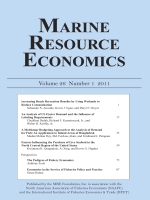The public swimming beach at Maumee Bay State Park (MBSP) on Lake Erie is often posted for occurrences of unsafe levels of bacteria. The main source of bacteria derives from a drainage ditch that discharges near the beach. We have conducted a comprehensive study to determine the feasibility of using a constructed wetland to filter the ditch water, prior to its entry into Maumee Bay. As part of this study, we administered an on-site non-market valuation survey of beach visitors, in which observed and contingent trips to the beach were used to estimate the potential welfare benefits of the restored wetlands. The data were analyzed using three versions of the multivariate Poisson-lognormal (MPLN) model, a random effects count data model. We conclude version one, with flexible covariance structure and vehicle costs of $0.25 per mile, is the preferred version and use it to estimate an average annual willingness to pay (WTP) of $166 to construct wetlands and improve water quality. The aggregate annual benefit to an estimated 37,300 annual beach visitors is estimated as $6.19 million. The robustness of this estimate to a variety of alternative assumptions is examined.
JEL Classification Code: Q51





